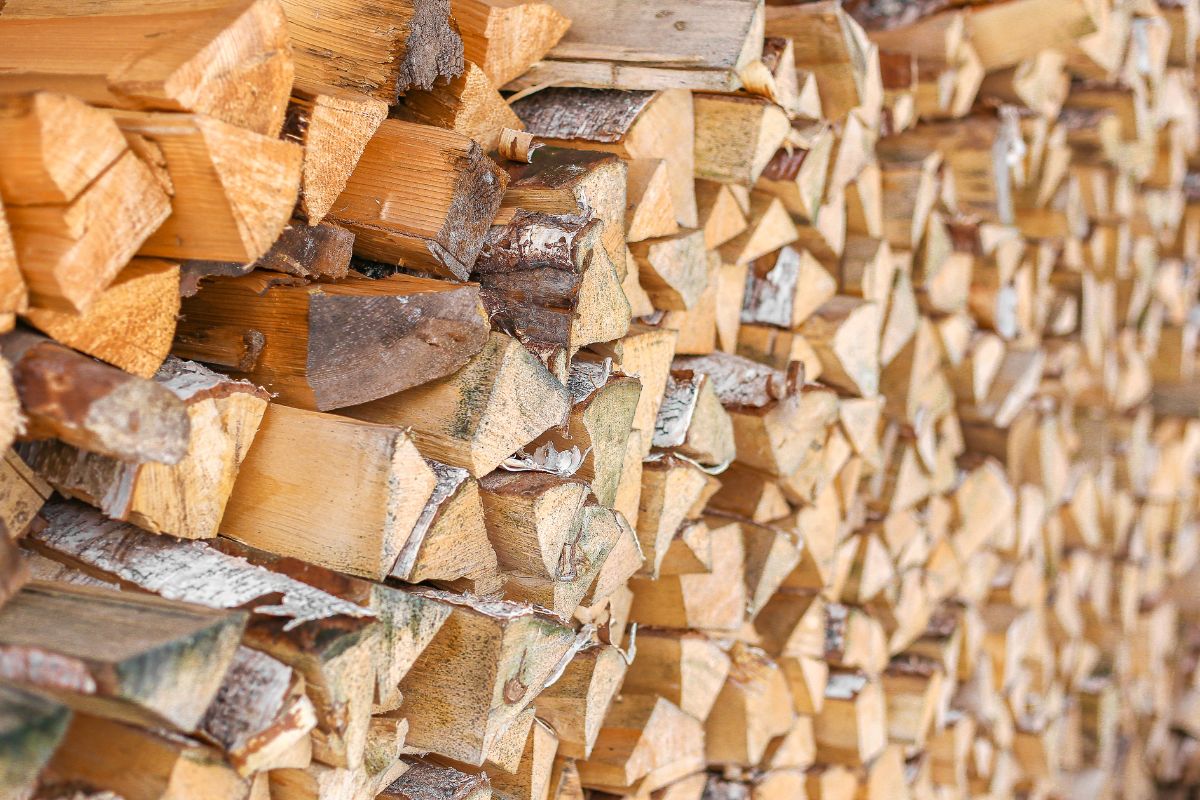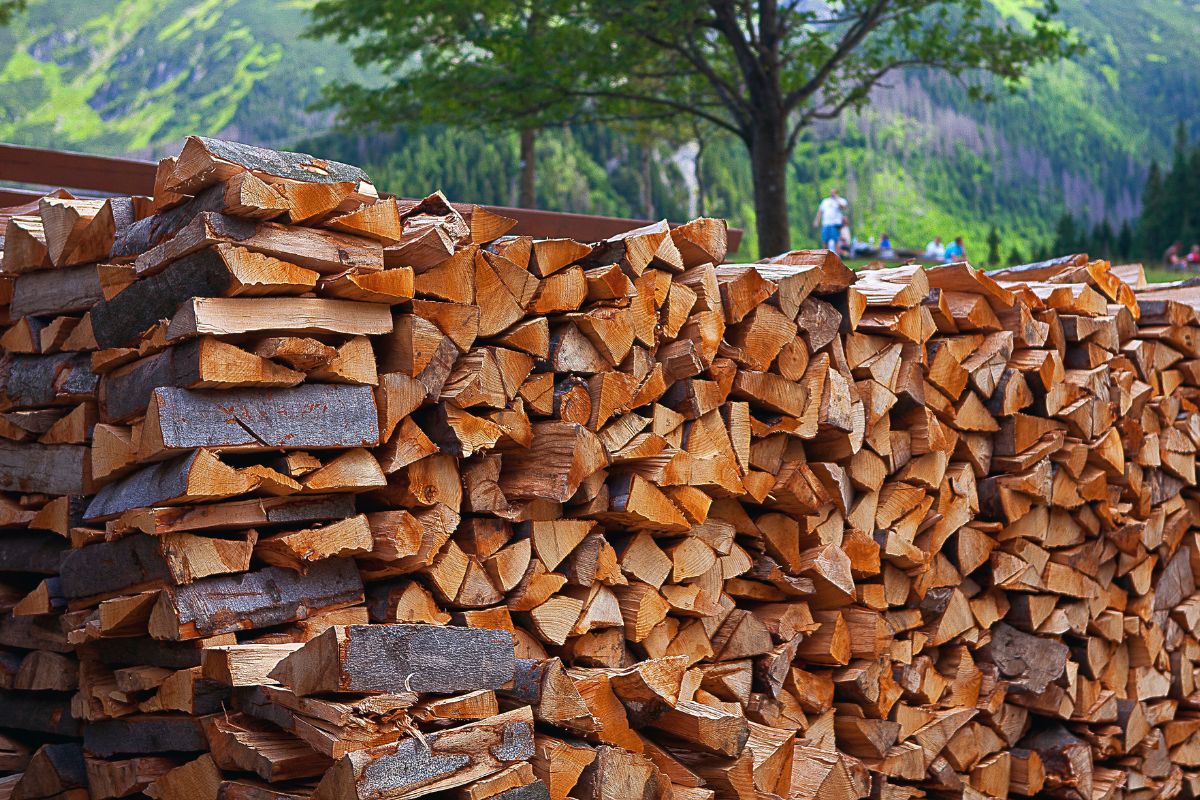If you’re new to owning a fireplace, you might be wondering, what exactly is a rick of wood?

In short, a rick of wood is a unit of measurement for firewood. It’s typically a pile of wood that measures 4 feet tall, 8 feet long, and one log-length deep.
However, there’s more to learn about ricks of wood, including the different types of wood you can use, the best way to stack and store your firewood, and how to properly season it for optimal burning.
In this article, we’ll cover everything you need to know about ricks of wood.
What Is A Rick Of Wood?
Definition
A rick of wood is a unit of measurement for firewood, typically used for personal fireplaces or wood-burning stoves.
It refers to a pile of wood that is usually 4 feet tall, 8 feet long, and one log-length deep, although the exact dimensions can vary depending on the region.
What Other Terms For “Rick Of Wood” Are There?
The term “rick of wood” isn’t the only term used to describe this amount of firewood. In some regions, a rick of wood is referred to as a face cord, which is a similar measurement of wood but typically only one log-length deep.
A full cord, on the other hand, is a larger measurement of firewood that is 8 feet long, 4 feet tall, and 4 feet deep.
It’s important to know these different terms and measurements when purchasing or selling firewood to ensure you’re getting the right amount.
The Types Of Wood Used In A Rick
What Types Of Wood Are Used In Firewood?
There are a number of different types of wood commonly used for firewood, each with their own unique characteristics. Some of the most popular types of firewood include oak, maple, birch, ash, and cherry.
Oak is a hardwood that burns slowly and produces a high amount of heat, making it a popular choice for long-burning fires. Maple is another hardwood that burns well and produces a sweet-smelling aroma.
Birch is a softwood that burns quickly and produces a bright flame, but it doesn’t produce as much heat as hardwoods. Ash is a hardwood that produces a steady flame and is easy to split, making it a popular choice for firewood.
Cherry is a hardwood that burns slowly and produces a sweet aroma, but it can be more difficult to split than other types of wood.
Type Of Wood And The Effect On The Size And Weight
The type of wood you choose for your firewood can affect the size and weight of your rick of wood. Hardwoods are typically heavier and denser than softwoods, which means that a rick of hardwood will contain fewer pieces of wood than a rick of softwood.
Additionally, the size of the logs you use can also affect the size and weight of your rick of wood. Larger logs will take up more space in your rick, while smaller logs will allow you to fit more wood into a smaller space.
How Much Wood Is In A Rick?

For Standard Ricks
A standard rick of wood is typically 4 feet tall, 8 feet long, and one log-length deep. This means that a rick of wood contains approximately 128 cubic feet of wood.
To estimate the amount of wood in a rick, you’ll need to measure the dimensions of the pile and multiply them together to get the cubic footage.
For example, if your pile is 4 feet tall, 8 feet long, and one log length deep, you would multiply 4 x 8 x 1 to get 32 cubic feet. Then, you would multiply that number by four to get the total cubic footage of a standard rick, which is 128 cubic feet.
What Can Affect The Amount Of Wood In A Rick?
However, the amount of wood in a rick can vary depending on a few factors, including the type of wood, the size of the logs, and how tightly the wood is stacked can all affect the amount of wood in a rick.
Purchasing And Storing A Rick Of Wood
Where Can You Purchase A Rick Of Wood?
A rick of wood can be purchased from a variety of sources, including local firewood suppliers, online retailers, and even neighbors who may have extra wood, so you should have no trouble finding some local to you.
How To Select Firewood
When it comes to selecting firewood, it’s important to choose the wood that has been properly seasoned, is free from mold or insects, and has a low moisture content, which will help to ensure it burns efficiently.
How To Store Firewood
When storing firewood, you should always ensure that your firewood should be stored in a dry, well-ventilated area in order to prevent mold growth, as well as allowing the wood to properly dry out.
If you’re going to be stacking the wood off the ground, then you’ll want to cover it with a tarp, which will help protect it from rain and snow. It’s best to purchase firewood well in advance to ensure it has time to properly season before use.
Using A Rick Of Wood
Best Practices When Using Firewood
When using firewood, it’s important to follow best practices to ensure safety and efficiency. This includes always using a screen to prevent sparks from flying out of the fireplace or wood-burning stove, and never leaving a fire unattended.
If you need to stack a rick of wood, then you should start with a solid base, before stacking the wood tightly together, as well as alternating the direction of the logs, which will help to increase the overall stability.
How To Estimate How Long A Rick Of Wood Will Last
To estimate how long a rick of wood will last, consider the size of the logs, the type of wood, and how often you’ll be using the fire.
On average, a rick of wood will last a typical household several weeks to a few months, but this can vary depending on usage and other factors.
Conclusion
We hope that this guide has been helpful for you in finding out more about ricks of wood, whether you wanted to learn more about the types of wood commonly used for firewood, how to estimate the amount of wood in a rick, where to purchase firewood, best practices for using firewood, or how to properly store and stack a rick.
Just remember, always purchase firewood that is dry, with no mold or signs of insects, and to buy it ahead of use to ensure that it has plenty of time to season.
When storing, always cover with a tarp, and stack it together tightly for optimum stability.
- How To Open Chimney Flue - July 20, 2023
- Do Electric Fireplaces Use A Lot Of Electricity? - July 20, 2023
- How To Keep A Fire Going - July 20, 2023








